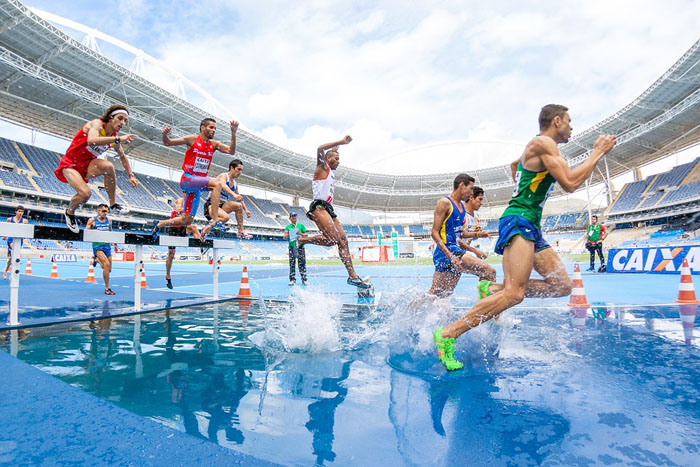Launching official merchandise can be a game-changer for sports teams. It boosts brand loyalty, generates revenue, and connects fans to their favorite players. But before diving in, teams must navigate a maze of legal requirements to ensure smooth sailing.
 steeple jumpers
steeple jumpersFailing to address these steps can lead to costly disputes and tarnished reputations. Professional sports teams must handle legal intricacies like trademark searches, copyright laws, licensing agreements, and player contracts' intellectual property rights.
Here's a guide outlining the critical legal steps every team should follow before launching merchandise.
1. Conduct Thorough Trademark Searches
Before printing that new jersey design, sports teams must ensure no one else owns a similar trademark. This step is vital to avoid legal battles and protect the team's brand identity. Teams can conduct trademark lookups using resources like the Canadian Intellectual Property Office for those in Canada or the United States Patent and Trademark Office for searches in the U.S.
A comprehensive search prevents potential infringement on existing trademarks, which could lead to expensive lawsuits and forced product recalls.
Remember, enlisting an intellectual property attorney adds an extra layer of security in the efforts to safeguard merchandise's market entry and set a strong foundation for future product launches.
2. Understand Copyright Law
Copyright law protects original works like logos, designs, and slogans used on merchandise. Sports teams need to ensure that all elements of their merchandise are either original creations or properly licensed from the copyright holder. Using copyrighted material without permission can lead to legal disputes and hefty fines.
Teams should collaborate with graphic designers and marketing professionals who understand copyright nuances.
Additionally, they should keep records of licensing agreements for any third-party content used in their products. Staying informed about copyright laws helps prevent legal troubles, ensuring that every piece of merchandise respects intellectual property rights while providing fans with unique and authentic gear.
3. Negotiate Licensing Agreements
Licensing agreements are crucial when sports teams collaborate with third-party manufacturers or designers. These agreements specify how logos, player images, and team colors can be used on merchandise. Properly negotiated contracts ensure both parties understand their rights and obligations.
A clear licensing agreement helps avoid conflicts over profit sharing, product quality, and distribution rights. It’s wise to involve a legal expert in drafting these documents to cover all bases comprehensively.
Teams should detail the scope of usage, duration of the license, geographical reach, and any exclusivity clauses to protect brand integrity while fostering beneficial partnerships that amplify merchandise success in the market.
4. Respect Player Contracts' Intellectual Property Rights
Player contracts often contain clauses regarding the use of their likeness, names, and other personal attributes. Sports teams must carefully review these agreements before featuring players on merchandise. Ignoring these terms can result in legal challenges from players or their representatives.
Teams should work closely with agents and legal advisors to negotiate permissions for using player images and names on products like jerseys, posters, and collectibles. It's essential to secure written consent from players to avoid potential conflicts down the road.
This ensures that all merchandise complies with contractual obligations while maintaining positive relationships between teams and athletes, ultimately delivering authentic products that fans love.
5. Ensure Product Safety and Compliance
The final step involves guaranteeing that all merchandise meets safety standards and complies with local regulations. This means conducting thorough testing on materials used in products like apparel, toys, and accessories to ensure they are safe for consumers.
Sports teams should familiarize themselves with relevant consumer protection laws and industry guidelines. Partnering with reputable manufacturers who adhere to these standards is essential. It's also wise to include detailed product labels with information about material content, care instructions, and any safety warnings.
Conclusion
Launching official merchandise involves more than just great design ideas. Sports teams must navigate a complex web of legal requirements to ensure their products hit the market without a hitch. From conducting thorough trademark searches to ensuring product safety, each step plays a crucial role in protecting the team’s brand and reputation.
By diligently following these legal steps, teams can confidently release merchandise that fans love, fostering stronger connections and driving successful sales while steering clear of costly legal pitfalls.
Related Pages
- How to Study Sports Law
- What does a Sports Lawyer do?
- All About Sports Law
- Dressing for Success: How Athletes Use Fashion to Stand Out Off the Field
- Collectible Sporting Clothing
- Sports Marketing — including the job as a Sports Agent.
- Sport Businesses — How to start a business in the fitness industry.


 Current Events
Current Events